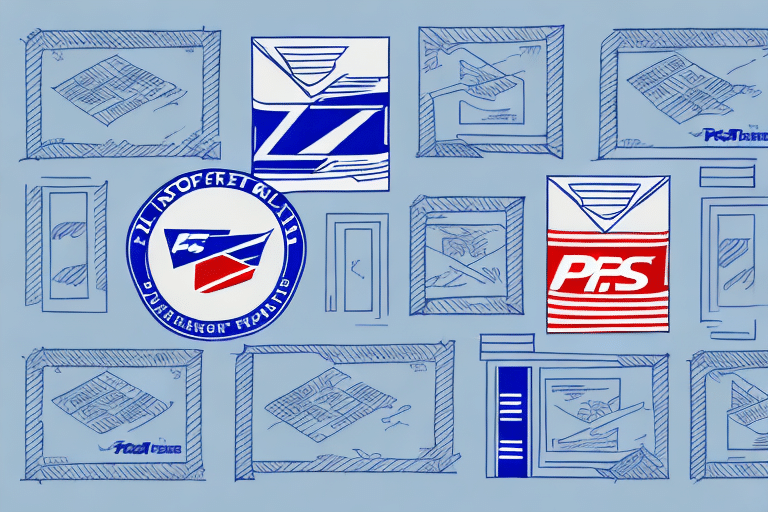Is USPS Cheaper Than FedEx? A Cost Comparison
When it comes to shipping items domestically or internationally, one of the biggest concerns for businesses and individuals alike is the cost. Two of the most popular shipping carriers in the United States are the United States Postal Service (USPS) and FedEx. But which one offers the best value for money? In this article, we'll take a closer look at the pricing models of both carriers and compare their shipping rates for different shipment types and sizes. By the end of this article, you'll have a clearer understanding of which carrier is the more affordable and suitable option for your shipping needs.
Understanding the Pricing Models of USPS and FedEx
Before diving into the specifics of the shipping rates, it's important to understand how USPS and FedEx structure their pricing models.
USPS primarily uses weight and distance to determine the cost of shipping, whereas FedEx uses a combination of weight, dimensions, distance, and delivery speed. Additionally, FedEx offers various shipping services, such as same-day delivery and next-day delivery, which come at a higher cost compared to USPS, which primarily offers ground and priority mail options.
Both USPS and FedEx offer discounts for certain types of shipments. USPS provides discounted rates for businesses that ship in bulk, while FedEx offers discounts for frequent shippers and those who use their online shipping tools. Exploring these options can lead to significant savings if you plan on shipping frequently or in large quantities.
What Factors Affect the Shipping Costs of USPS and FedEx?
Apart from the pricing models, several other factors can influence the shipping costs of both carriers. These include:
- Package dimensions and weight: Both USPS and FedEx have specific rules based on the size and weight of the package. Packages that exceed these limits often incur additional fees.
- Delivery speed: The faster the delivery, the higher the cost. Time-sensitive deliveries will naturally cost more.
- Delivery location: The distance between the origin and destination plays a role in determining the cost. International shipments often include customs fees and border taxes, increasing the overall cost.
- Additional services: Both carriers offer services such as insurance, signature confirmation, and advanced tracking. These services come at an additional cost and can add up quickly.
Another factor affecting shipping costs is the type of item being shipped. Items like hazardous materials or fragile goods require special handling and packaging, which can increase shipping expenses.
The time of year can also impact shipping costs. During peak holiday seasons, carriers may raise their prices due to high demand and increased volume of packages.
Comparison of USPS and FedEx Shipping Rates for Domestic Shipments
For domestic shipments, USPS generally offers lower prices compared to FedEx for smaller packages. However, for larger and heavier packages, FedEx may provide better value for money. For example, a 1-pound package shipped from New York City to Los Angeles via USPS's Priority Mail costs around $10.50, whereas the same package shipped via FedEx Ground costs approximately $8.10. For a 10-pound package, USPS Priority Mail costs about $45, while FedEx Ground charges around $30 for the same shipment.
Both USPS and FedEx offer additional services that can affect the overall shipping cost. For instance, USPS provides free package pickup from your home or office, whereas FedEx may charge a fee for this service. Additionally, FedEx offers a broader range of delivery options, including same-day and next-day delivery, which are more expensive but beneficial for urgent shipments. Considering all these factors is crucial when choosing between USPS and FedEx for your domestic shipping needs.
Comparison of USPS and FedEx Shipping Rates for International Shipments
International shipments highlight the pricing differences between USPS and FedEx even more. While USPS may offer cheaper prices upfront, international shipments often incur additional fees and taxes that can rapidly increase the total cost. Moreover, although USPS provides tracking information for international shipments, FedEx offers more comprehensive tracking, making it easier to monitor your package's progress.
Delivery time is another critical factor when choosing between USPS and FedEx for international shipments. FedEx generally offers faster delivery times with options for express and priority shipping. In contrast, USPS may take longer to deliver international packages, especially to remote or less accessible locations. Assessing your specific needs and timelines is essential when deciding which carrier to use for your international shipments.
Is USPS or FedEx More Affordable for Small Business Owners?
The cost of shipping can significantly impact the bottom line for small business owners. Generally, USPS is considered the more affordable option for small, lightweight packages. However, as package size and weight increase, FedEx may offer better value for money. Additionally, FedEx provides more comprehensive and customizable shipping options for businesses requiring greater flexibility.
The location of your business and the destination of your packages also influence shipping costs. USPS may be more cost-effective for domestic shipments, while FedEx might offer better rates for international shipping. It's advisable to compare rates and services from both carriers to determine which one best fits your business needs.
Shipping Large Items: Which Carrier is the Best Option?
Individuals or businesses shipping large items, such as furniture or equipment, may find FedEx to be the better option. FedEx offers specialized shipping services, like freight shipping and white-glove delivery, which can handle large and bulky items that exceed USPS's size and weight limits. Additionally, FedEx provides tracking and insurance options that offer more peace of mind when shipping high-value items.
However, while FedEx may be better suited for large items, it might not always be the most cost-effective choice. It's important to compare shipping rates and services from multiple carriers, including UPS and DHL, which also offer specialized shipping services for oversized and heavy items, to determine the best option for your specific needs.
How to Save Money on Shipping Costs with USPS and FedEx
Saving money on shipping costs is achievable through several strategies. One effective method is using USPS's flat-rate boxes and envelopes, which offer a fixed price regardless of the package's weight or destination. Alternatively, you can compare rates between USPS and FedEx to choose the option that provides the most value for money. Consolidating multiple packages into a single shipment can also lead to long-term savings.
Taking advantage of discounts and promotions offered by USPS and FedEx is another way to reduce shipping costs. Both companies provide discounts for businesses and frequent shippers, as well as seasonal promotions and special deals. Regularly checking their official websites can help you stay informed about current offers that can help you save on shipping expenses.
Quality vs. Price: Which Carrier Offers Better Value for Money?
In terms of quality and reliability, both USPS and FedEx have excellent reputations. However, for individuals or businesses that require more comprehensive and customizable shipping options or need greater assurance when shipping high-value items, FedEx may offer better value for money. On the other hand, if your primary focus is on cost-effectiveness and shipping smaller items, USPS could be the more suitable option.
The speed of delivery is another crucial factor in determining value for money. While both carriers offer express shipping options, FedEx generally boasts faster delivery times than USPS. This can be particularly important for time-sensitive shipments, such as perishable goods or urgent documents.
Additionally, if you frequently ship internationally, FedEx may be the better choice due to its larger global network and more extensive international shipping options compared to USPS. However, if your shipping needs are primarily domestic within the United States, USPS may prove to be a more convenient and cost-effective option.
Time-Sensitive Deliveries: Which Carrier is Faster and Cheaper?
For time-sensitive deliveries, FedEx typically offers faster shipping speeds compared to USPS. However, this increased speed often comes at a higher cost. If you are operating on a tight budget and the delivery timeframe is flexible, USPS may be the more economical choice.
Both carriers provide various shipping options with different delivery speeds and associated costs. For example, FedEx offers same-day delivery for urgent shipments, but this service can be quite expensive. Conversely, USPS offers Priority Mail Express, which guarantees overnight delivery to most locations in the US at a lower cost than FedEx's same-day service. Evaluating your specific needs and budget is essential when choosing between these carriers for time-sensitive deliveries.
Hidden Fees and Charges: What You Need to Know About USPS and FedEx
Both USPS and FedEx have additional fees and charges that may not be immediately obvious when shipping your package. Examples of these fees include fuel surcharges, residential delivery fees, and additional handling fees for oversized packages. Before selecting a shipping carrier, it's crucial to review their fee schedules and factor these into your overall shipping costs.
Another important aspect to consider is the delivery speed offered by each carrier. While USPS provides a range of delivery options, including Priority Mail and First-Class Mail, FedEx is renowned for its fast and reliable overnight and two-day delivery services. However, these expedited services come with higher price tags, making it important to weigh the cost against the speed of delivery.
Both USPS and FedEx offer insurance options for your packages, but the coverage and costs vary. USPS provides up to $5,000 in insurance coverage for Priority Mail and up to $50,000 for Priority Mail Express. In contrast, FedEx offers up to $100 in coverage for free, with options for additional coverage at an extra fee. When deciding on insurance options, consider the value of your package and the potential risks involved in shipping it.
Tracking and Insurance: A Comparison Between USPS and FedEx Services
Both USPS and FedEx offer tracking and insurance services for their packages, but the level of detail and coverage differs between the two carriers. FedEx provides more comprehensive tracking information and a broader range of insurance coverage options compared to USPS. Additionally, USPS only offers limited tracking information for international shipments, whereas FedEx ensures detailed tracking throughout the shipping process.
Customer Support: Which Carrier Offers Better Support Services?
When it comes to customer support, both USPS and FedEx offer multiple support channels, including phone, email, and live chat. However, FedEx's customer support services generally receive higher ratings compared to USPS. FedEx provides dedicated support channels for business clients and offers more personalized assistance for package tracking and delivery updates, enhancing the overall customer experience.
Conclusion: Is USPS or FedEx the Best Option for Your Shipping Needs?
Ultimately, the choice between USPS and FedEx depends on your specific shipping needs and priorities. USPS offers cheaper prices for smaller and lightweight packages, making it an excellent choice for cost-conscious shippers. On the other hand, FedEx may provide better value for money for larger or more customized shipments, along with faster shipping speeds, more comprehensive tracking and insurance options, and superior customer support services. Before selecting a shipping carrier, carefully consider the factors that influence your shipping costs and preferences to make an informed decision that best suits your requirements.






















